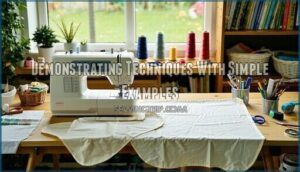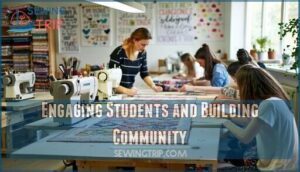This site is supported by our readers. We may earn a commission, at no cost to you, if you purchase through links.

You’ll need to create structured lesson plans with clear learning objectives, prepare organized supply kits, and set up dedicated workstations with proper machine access.
Start by demonstrating basic techniques through hands-on examples—practice straight stitching on paper before touching fabric, and use methods like the "burrito technique" for pillowcases to teach layering skills.
Focus on one technique per session, provide printed reference materials, and track each student’s progress with simple checklists.
The secret lies in transforming chaotic craft time into focused, skill-building instruction that connects each lesson to previously learned abilities.
Table Of Contents
Key Takeaways
- Start with simple projects and machine control – Choose confidence-building projects like pillowcases or tote bags, and practice machine control on paper before threading to prevent frustration
- Create structured lesson plans with clear progression – Map out learning sequences that build skills systematically, from basic stitching to complete projects, with checkpoints to track student progress
- Organize your workspace efficiently – Set up dedicated zones for cutting, sewing, and pressing with adequate space, proper lighting, and accessible power outlets to prevent bottlenecks
- Focus on demonstration and support materials – Use hands-on examples like the "burrito technique," provide printed reference guides, and maintain manageable class sizes (6-8 beginners) for optimal attention
Planning Your Sewing Lessons
Planning your sewing lessons starts with choosing the right projects and preparing everything your students need to succeed.
You’ll want to match simple projects like pillowcases or tote bags to your available class time, then create clear supply lists and step-by-step instructions that keep everyone on track, focusing on achievable goals.
Selecting Beginner-friendly Projects
When choosing beginner sewing projects, you’ll want to focus on simple patterns that build confidence without overwhelming new sewers.
Select projects with straight seams and minimal steps to guarantee success in your sewing classes.
- Pillowcases and tote bags – These beginner patterns use basic straight stitching and can be completed in one session
- Scrunchies and keychains – Perfect simple crafts that require minimal fabric choices and basic machine skills
- Drawstring bags – Combine straight seams with simple closures, ideal for sewing instruction without complex fitting
For successful sewing lessons, having the right sewing kits is essential to get started with these projects.
Matching Project Complexity to Class Time
Time constraints shape every sewing lesson’s success.
Smart planning beats last-minute scrambling—match your project to your time, not your wishful thinking
Match your project selection to available hours, ensuring students complete satisfying work without rushing.
Simple projects like scrunchies work for 1-hour sessions, while tote bags need 2-3 hours.
| Class Duration | Recommended Projects |
|---|---|
| 1-2 hours | Scrunchies, keychains, simple bookmarks |
| 2-3 hours | Pillowcases, basic tote bags, placemats |
| 4+ hours | Lined tote bags, simple garments, quilted items |
Consider your students’ skill levels when planning lesson timing.
Beginners need extra time for machine setup and basic techniques, while experienced sewers move faster through instructions.
Building a Structured Lesson Plan
Create a detailed lesson plan that maps out Learning Objectives and Teaching Methods for each session.
Your curriculum design should include sequential skill-building activities, from unthreaded machine practice to completed projects.
Structure your sewing lessons with clear checkpoints for Student Assessment, allowing you to gauge progress before advancing, which transforms chaotic craft time into focused sewing instruction that builds confidence through mastery.
Preparing Supply Lists and Kits
Before class begins, develop thorough supply kits that set your students up for success.
Include essential sewing tools like scissors, pins, and measuring tape alongside carefully selected fabric choices that match your project’s difficulty level.
Create detailed notion lists covering thread selection, bobbins, and needles.
Well-organized sewing supplies eliminate confusion and keep everyone focused on learning rather than hunting for materials.
Having the right basic sewing supplies is vital for a successful sewing lesson, as it ensures that students have all the necessary tools to complete their projects, leading to a more productive and enjoyable learning experience.
How to Give Sewing Lessons Step by Step
Creating a structured lesson plan transforms sewing instruction from overwhelming chaos into manageable, confidence-building steps that students can actually follow.
You’ll need to break down each technique into clear demonstrations, provide visual guides, and establish checkpoints where students can celebrate their progress before moving forward, which ultimately leads to manageable steps.
Mapping Out a Clear Learning Sequence
Before diving into actual sewing techniques, you’ll need to establish a logical learning path that builds skills systematically.
Effective lesson planning requires careful curriculum design that moves from foundational concepts to complex applications, ensuring each step prepares students for the next challenge.
- Start with machine basics – Threading, tension, and basic controls before touching fabric
- Progress through stitching skills – Straight lines, curves, then pivoting techniques
- Layer construction methods – Simple seams before advanced finishing techniques
- Build toward complete projects – Each lesson should connect to previous skills learned
Your sewing instructor approach should include regular skill assessment checkpoints and progress tracking systems.
This structured learning path prevents overwhelm while building confidence through achievable milestones in your sewing class setup.
Demonstrating Techniques With Simple Examples
Show your students the "burrito method" for pillowcases—this simple technique demonstrates how fabric layers wrap together.
Use free patterns from American Patchwork and Quilting for reliable sewing tutorials. Practice straight stitching on paper first, teaching machine tips without thread tangles.
Focus on one stitch type per lesson, like running stitch for hand sewing. Your sewing instruction becomes clearer when students master fabric choice and thread control through concrete examples.
Understanding basic sewing lessons is essential for mastering sewing machine operations and troubleshooting common issues.
Using Checklists to Track Student Progress
Effective progress tracking transforms chaotic sewing lessons into organized learning experiences.
Develop simple checklists covering key sewing skills like threading machines, controlling stitch lines, and completing seam allowances.
Mark off each student’s accomplishments during class, creating clear learning metrics that show advancement, and use these student assessment tools to identify who needs extra support and who’s ready for advanced techniques.
These tools help make your sewing instruction more targeted and successful.
Providing Printed Directions for Reference
Printed reference materials empower your students to continue learning beyond the classroom.
Always provide clear pattern instructions and lesson handouts for each project. Include fabric templates, sewing guides, and detailed sewing project steps they can follow at home.
These reference materials become their roadmap to independence, transforming nervous beginners into confident sewers who tackle projects solo, and enabling them to become confident sewers with the ability to follow detailed sewing project steps.
Organizing Your Sewing Classroom
A well-organized sewing classroom makes the difference between chaos and smooth learning.
A well-organized classroom transforms sewing chaos into learning magic
You’ll need to set up distinct work zones and make certain everyone has easy access to power outlets before your first student arrives.
Choosing and Preparing The Location
Before you begin sewing class logistics, secure a venue that meets your students’ needs.
Look for spaces with adequate square footage—at least 30 square feet per student—plus accessible parking and public transportation.
Verify electrical outlet availability, lighting quality, and temperature control.
Check accessibility features like ramps and wide doorways.
Confirm scheduling flexibility and storage options for your sewing workshop materials, ensuring a smooth operation for your sewing class.
Arranging Tables and Workstations
Arrange tables to accommodate at least four people working simultaneously. Position each workstation with adequate elbow room and clear sight lines to your demonstrations.
Space tables to allow easy movement between stations during instruction. Consider workflow patterns—students will move from cutting to pinning to sewing.
Smart table layout prevents bottlenecks and creates smooth classroom design for ideal sewing class logistics. Effective use of sewing tables can enhance the overall learning experience by ensuring a well-organized and efficient workflow, which is crucial for a successful sewing class.
Setting Up Dedicated Zones for Each Task
Organize your sewing classroom into distinct work areas to maintain smooth traffic flow and prevent bottlenecks during lessons.
This approach helps sewing teachers manage multiple students efficiently while ensuring safety protocols are followed.
Create these three dedicated zones:
- Cutting station – Large table with cutting mats, rulers, and fabric templates
- Sewing area – Machines positioned for ideal ergonomic considerations and accessibility needs
- Pressing zone – Iron, ironing board, and heat-resistant surface away from main traffic
Each zone’s size should accommodate at least four people working simultaneously without crowding.
Good lighting is also key, so consider task lighting options for each station.
Ensuring Access to Outlets and Extension Cords
Power up your sewing instruction with proper outlet availability planning.
Count sewing machines, irons, and lighting needs before your sewing class begins.
Bring at least two extension cords and power strips to prevent circuit load issues.
Test cord safety by checking for frays or damage.
Position extension length strategically around workstations.
Smart sewing teachers who teach sewing courses online know electrical preparation separates successful workshops from chaotic ones, and it is a key factor in a successful workshop.
Managing Class Size and Equipment
Getting the right balance of students and equipment makes the difference between a smooth lesson and chaos.
You’ll need to match your class size to both your experience level and the complexity of your chosen project, which involves finding a balance that works for your specific teaching situation.
Determining Optimal Class Size for Skill Level
Start with fewer students when you’re getting your bearings.
Beginner classes work best with 6-8 participants, giving you that sweet 1:6 student ratio for proper attention.
Intermediate groups can handle up to 12 people since they need less hand-holding.
Advanced workshops might accommodate 16 students if they’re working collaboratively and don’t require constant guidance.
Allocating Sewing Machines and Tools
Strategic machine allocation transforms your sewing class from chaos into smooth productivity. Consider each student’s skill level when distributing equipment, ensuring beginners receive reliable machines while experienced sewers can handle temperamental ones.
- One machine per two students works well for simple projects like pillowcases
- Individual machines become essential for complex garments requiring detailed guidance
- Shared cutting tools and irons maximize efficiency across all sewing stations
Test every sewing machine beforehand to prevent mid-lesson breakdowns that derail your teaching flow. Investing in high-quality sewing machine equipment is essential for a successful class.
Coordinating Shared Equipment Use
Through effective Equipment Allocation and Tool Management, you’ll maximize learning time while minimizing chaos.
Establish clear sewing machine sharing protocols—pairs rotate every thirty minutes for simple projects.
Create supply coordination stations where students collect tools, then return them to designated spots.
This workspace optimization prevents the "musical chairs" effect that derails lessons faster than tangled thread, ensuring a more efficient use of Tool Management.
Teaching Techniques for Beginners
Starting with machine control before introducing thread prevents frustration and builds confidence in new sewers.
You’ll teach essential techniques like straight stitching, curves, and pivoting while using practical tools like fabric templates to guarantee accuracy and success.
Practicing Machine Control Before Threading
Most beginners feel overwhelmed when they first see a sewing machine. Start with Machine Basics by having students practice unthreaded sewing machine control on paper templates. This approach eliminates thread tangles while building essential sewing machine skills.
Here’s your step-by-step sewing practice routine:
- Speed Control Drills – Practice sewing machine speed using the foot pedal on drawn lines
- Needle Positioning – Learn to stop with needle down for precise pivoting
- Presser Foot Management – Master lifting and lowering for smooth fabric handling
- Pattern Following – Trace printed templates to develop steady stitch control
This method reduces anxiety and prevents costly mistakes during initial sewing machine techniques training. Mastering the foot pedal control is essential for efficient sewing machine operation.
Introducing Straight and Curved Stitching
Once students master basic machine control, you’ll guide them through their first stitching exercises. Start with straight lines using practice sheets, then progress to curves and corners.
| Skill Level | Technique | Focus Area | Practice Method |
|---|---|---|---|
| Beginner | Straight lines | Stitch Control | Follow printed guidelines |
| Intermediate | Gentle curves | Sewing Speed | Gradual arc exercises |
| Advanced | Sharp corners | Thread Management | Pivot with needle down |
| Mastery | Complex shapes | Curve Techniques | Free-form fabric practice |
Your sewing instruction online should emphasize consistent speed and fabric choice for ideal results during sewing training sessions.
Using Fabric Templates for Accuracy
Paper templates shift during cutting, causing inaccurate pieces.
Create fabric templates instead for better sewing precision.
Cut templates from sturdy cotton or canvas using your sewing patterns.
These reusable guides guarantee consistent fabric cutting and pattern accuracy across multiple projects.
Pin templates securely to your material selection before cutting.
Save time in future sewing instruction online sessions by storing labeled templates.
This technique improves overall project quality while building confidence in template making skills for any sewing class tips you share, and enhances sewing precision.
Awarding a “sewing License” for Mastery
Once your students demonstrate control over their sewing machine through practice sheets and fabric scraps, it’s time to recognize their achievement.
Create a simple sewing license certificate that acknowledges their mastery of basic sewing techniques. This sewing certification milestone validates their skill levels and builds confidence before tackling their first complete project in your sewing class, which is a significant mastery of skills and leads to a sewing certification.
Engaging Students and Building Community
Creating an engaging sewing classroom goes beyond teaching techniques—it’s about building connections that keep students motivated and excited to learn.
You’ll foster creativity while helping students support each other through shared challenges and successes.
Encouraging Collaboration and Sharing
Sewing circles thrive when participants share techniques and resources freely.
Encourage peer feedback during group projects by pairing experienced sewers with beginners.
Create team building opportunities through shared resources like fabric swaps or pattern exchanges.
Foster your sewing community through community outreach projects, making quilts for shelters or teaching at libraries.
This collaborative approach transforms individual sewing education into meaningful connections.
Effective sewing workshops often rely on a well-planned sewing workshop structure to guarantee a productive learning environment.
By following these steps, you can create a sewing community that is supportive and engaging, and where participants can learn from each other and grow in their skills, leading to a more collaborative approach.
Adapting Lessons for Children and Groups
Children require customized approaches that match their developmental stages and group dynamics.
Adjust your sewing education methods based on age, attention spans, and motor skills to create engaging classroom management experiences.
When teaching sewing skills, it’s vital to focus on proper safety rules guidelines to guarantee a safe learning environment.
- Ages 4-7: Use hand sewing with felt and embroidery thread for kid friendly projects like simple shapes
- Ages 8-10: Introduce machine sewing in groups with close supervision and sewing games
- Ages 11+: Allow independent work with real tools while teaching sewing for beginners fundamentals
- Group classes: Assign rotating roles and use team-based youth engagement strategies
Fostering Creativity and Self-confidence
Every student brings unique creative vision to your sewing class.
Encourage creative freedom by letting them choose fabric colors and personal style elements.
Celebrate mistakes as learning opportunities that build sewing confidence, and allow artistic growth through self expression rather than rigid perfection.
These sewing teaching methods create sewing joy while developing confidence building skills naturally.
Supporting Independent Practice and Growth
Give students clear homework assignments between sewing classes to build their practice routines.
Create skill tracking sheets so they can monitor progress independently, and share learning resources like online tutorials and pattern libraries.
Encourage student feedback about their challenges and victories, as this sewing instruction approach builds lasting sewing confidence beyond your classroom, and helps students develop a sense of independent progress.
Frequently Asked Questions (FAQs)
How do I start teaching a sewing class?
Ready to thread your first needle into teaching? Start small with 2-3 students, choose simple projects like pillowcases, and focus on machine control before threading to build confidence and skills.
What qualifications do I need to teach sewing?
You don’t need formal certifications to teach sewing. Strong sewing skills, patience, and ability to explain techniques clearly are essential. Consider taking teaching workshops or joining instructor networks for confidence-building.
What is the first thing to learn in sewing?
Rome wasn’t built in a day, and neither are sewing skills!
Start by mastering your machine’s basic controls through paper practice before threading it.
You’ll build confidence with straight lines before tackling real fabric projects.
What are the 5 steps in sewing?
Master these five sewing steps: plan your project, cut fabric pieces accurately, pin pieces together properly, sew seams with consistent seam allowances, and press seams flat for professional-looking results.
What are some recommended sewing machine brands for beginners?
Looking for a beginner sewing machine is like choosing your first car—you want reliability without complexity.
Brother, Singer, and Janome offer user-friendly models with clear instructions, automatic features, and good customer support that won’t overwhelm new sewists.
How long should each sewing lesson be?
Lesson duration depends on your project’s complexity.
For beginners, plan 1-2 hours for simple items like scrunchies.
Complex projects need 4-5 hours or multiple sessions.
Start shorter, adjust based on group’s pace.
What are some common mistakes beginners make when learning to sew?
You’ll likely rush into threading the machine first instead of practicing machine control on paper.
Don’t skip basic straight-line exercises or you’ll struggle with seam accuracy and thread tangling throughout your projects.
How do I choose the right fabric for a sewing project?
Consider your project’s purpose and skill level first.
Choose cotton fabrics for beginners—they’re forgiving and easy to handle.
Match fabric weight to your project: lightweight cotton for shirts, heavier canvas for bags.
Always buy slightly more than needed.
Are there any safety precautions I should take when teaching children to sew?
Safety shields young fingers from sharp tools.
Start with supervised hand-sewing using blunt-tipped needles and child-safe scissors.
Keep pin cushions away from reach. Always demonstrate proper techniques before letting kids practice independently, using blunt-tipped needles to ensure safety.
How do you handle disruptive students?
Stay calm but firm. Redirect their energy toward the project with specific tasks. Set clear boundaries early. Pair disruptive students with focused partners. Use positive reinforcement for good behavior.
Conclusion
Picture your students confidently threading needles and guiding fabric through machines with steady hands.
Teaching effective sewing lessons requires structured preparation, clear demonstrations, and patient guidance. You’ll create confident sewers by selecting appropriate projects, organizing your workspace efficiently, and building skills progressively.
Remember that knowing how to give sewing lessons means balancing technique with encouragement. Your students will develop both practical abilities and creative confidence through your thoughtful instruction.
Each completed project becomes a stepping stone toward independent sewing mastery.
- https://www.allpeoplequilt.com/millionpillowcases/instructions/RollItUp.pdf
- https://www.youtube.com/watch?v=s4yicT3Edbs&t=7s
- https://www.facebook.com/groups/1534102836917296/
- https://www.pinterest.com.au/colouredbuttons/tips-for-teaching-kids-to-sew/
- https://makeit-loveit.com/teaching-kids-sew-intro-sewing-machine

















